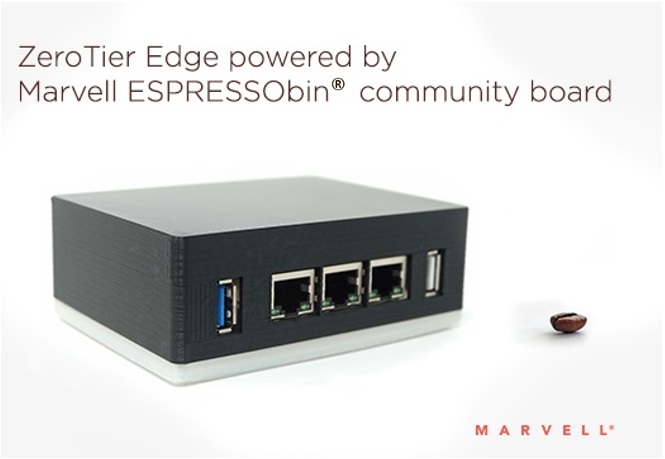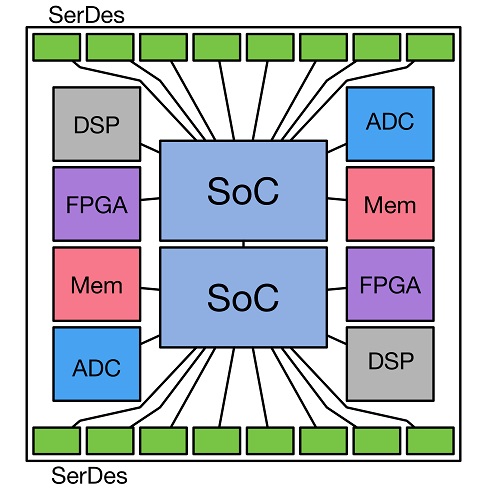

By Maen Suleiman, Senior Software Product Line Manager, Marvell
A number of emerging companies that serve the networking and data storage sectors are increasingly using Marvell’s popular community board – the Marvell ESPRESSObin® platform – in their product offerings. ZeroTier Edge is the latest appliance to be added to what is an ever growing list of such product offerings.
With this new product, Irvine-based start-up ZeroTier is looking to make the wide area network (WAN) much more local. According to ZeroTier, by using ZeroTier Edge, it is possible to create secure and robust LANs that can connect with a broad array of different devices across multiple locations. This means that a greater scope of equipment will now be able to gain access to virtual network infrastructure as it continues to be rolled out, without the associated software element needing to be installed.  This feature overcomes current obstacles that are holding back more widespread use of such connectivity. For example, in relation to some legacy equipment (office peripherals, building automation systems, surveillance cameras, industrial control mechanisms, etc.), installing this software simply isn’t an option, or in other cases (like where a large number of computers are involved), it is just impractical. Furthermore, using ZeroTier Edge mitigates the serious security issues that installing software onto a multitude of connected devices could potentially raise.
This feature overcomes current obstacles that are holding back more widespread use of such connectivity. For example, in relation to some legacy equipment (office peripherals, building automation systems, surveillance cameras, industrial control mechanisms, etc.), installing this software simply isn’t an option, or in other cases (like where a large number of computers are involved), it is just impractical. Furthermore, using ZeroTier Edge mitigates the serious security issues that installing software onto a multitude of connected devices could potentially raise.
Relying on Marvell’s ARMADA® system-on-chip (SoC) technology and open source software, the ZeroTier Edge is a compact and highly versatile unit that can be located on a desktop and addresses a plethora of software-defined networking applications. This unit delivers enterprise-grade VPN, SD-WAN and network virtualization functionality.
ZeroTier Edge basically acts as a pre-configured layer 2 bridge that provides the physical ports (both wired and wireless) needed to enable hardware (like the examples set forth above) to connect with virtualized networks. Its ease of use means that this unit can even be installed by non-IT staff. As a result, ZeroTier is able to offer enterprise customers a unique plug-and-play solution such that they can get the full benefit of software-defined networking without needing to implement the complex and costly bridging arrangements that would otherwise be required.
Each ZeroTier Edge unit incorporates a Marvell ESPRESSObin single board computing platform that has been purpose built for supporting open source development activity of this kind within the networking space. The board features a high performance ARMADA 3700 dual core 64-bit ARM®-based processor that is capable of running at speeds of 1.2GHz. This IC allows the ZeroTier Edge to deal with up to 1Gbps of incoming/outgoing encrypted data traffic.
Through the Marvell ESPRESSObin board, ZeroTier Edge can also take advantage of extensive I/O capabilities, with 3x Gigabit Ethernet ports, a USB 3.0 SuperSpeed interface, plus dual band 802.11ac Wi-Fi®, SATA (for connection to network data storage resources) and mini PCIe. 1GByte of on-board DRAM memory and 4GBytes of flash memory are supported, too, with provision for attaching additional memory capacity using the SD card slot. There are also ample GPIO pins available.
Thanks to the Marvell ESPRESSObin board’s ability to provide strong operational performance at an attractive price point, implementing ZeroTier Edge into customers’ networks doesn’t require a heavy investment. The product is currently going through the crowdfunding process and has already gained over 90% of its target figure. The initial units are expected to start shipping in early 2018.
For more information on ZeroTier Edge and the opportunity to support the project, visit: https://www.indiegogo.com/projects/zerotier-edge-open-source-enterprise-vpn-sd-wan#/
By Sree Durbha, Head of Smart-Connected Business, Marvell
The concept of a fully ‘connected home’ has been discussed for more than 20 years. However, widespread proliferation has taken far longer than anyone could have originally imagined. For a long time, deployment activity seemed to be limited to a relatively small number of high value installations. These installations were generally complicated to implement and their operation was not very user-friendly. Most importantly, they were composed of an amalgamation of isolated subsystems from different suppliers rather than a single universal system.
Even as home automation started to become accessible from smartphones and tablets, market fragmentation meant that each aspect of the automation technology installed within a home was still based on its own proprietary mechanism that needed a separate app to control it. As a result, home automation systems have often proven inconvenient and frustrating for those operating them and has unquestionably held back their adoption by consumers. The industry fragmentation and lack of interoperability between different vendor ecosystems meant that the consumer couldn’t really take advantage of the connected capabilities of all the various platforms.
The industry is innovating with solutions that seem finally likely to help broaden the appeal of home automation and accelerate its future progression. Through its HomeKit™ technology, Apple is looking to consolidate all the various verticals under a single, comprehensive home automation ecosystem that works together easily and securely. The HomeKit Accessory Protocol (HAP) is enabling hardware from different suppliers involved in home automation to communicate with Apple products (iPhone, iPad, Apple Watch) via a single, consistent, complete platform. This is done via wireless technologies like Bluetooth® Low Energy technology, as well as IP connectivity. The list of different ‘behaviors’ covered by the HomeKit hardware and software technology is extensive. Selecting a playlist for the audio system, turning on the lights in a particular room, remotely starting up home appliances (such as a washer/dryer), adjusting the heating and cooling, and activating the door entry system are just a few examples. But, because all of these functions are controlled via the Apple Home app or by asking Siri (rather than multiple apps), they can now work in tandem. For instance, settings can be configured so that if the curtains in a room were drawn, then the lighting would simultaneously turn on, or the ambient lighting could be changed to fit a certain music playlist.
Marvell is placing itself at the forefront of next generation smart home development through its support of Apple HomeKit. Our family of wireless SoC devices was the first in the industry to secure certification for the original HAP specification three years ago and has consistently been at the forefront as evidenced with our latest HomeKit Accessory Protocol Release 9 (HAP R9) specification. The low power 88MW30x ICs each possess an integrated microcontroller with Cortex®-M4 processing core, plus single-band IEEE 802.11n Wi-Fi® functionality. The truly transformational change this time is our SoCs’ certification for iCloud implementation, which enables remote control of HomeKit compliant devices using voice as well as the HomeKit App using iCloud® remote access. This means that OEMs serving the home automation market will be able to make their systems much more streamlined and convenient to seamlessly implement through iCloud. As a result, new use cases are now possible. For example, you can remotely start your thermostat to heat or cool your home using the Apple Home app (or Siri® voice control) while you are still on your way home from work and have the right temperature set for when you arrive.
This technology is showcased in the Marvell® EZ-Connect® HAP software development kit (SDK), which is designed to facilitate the implementation of HomeKit-enabled home automation accessories - accelerating our OEM customers’ design cycles and allowing products to be brought to market more quickly. Complementing its 802.11n wireless connectivity, the incorporated bridging functionality also allows interfacing with equipment using other RF protocols like Bluetooth low energy technology. For example, Marvell has partnered with a leading Bluetooth low energy vendor to offer a combo module reference design that is commercially available today through one of our module vendor partners, Azurewave. Our emphasis on security, encryption and memory partitioning allows secure, over-the-air firmware upgrades so that customer applications can run securely from external Flash memory while being encrypted on the fly. Our SDK also supports Amazon’s popular AWS cloud platform and Google’s Weave/Cloud as alternatives. To accompany the SDK, Marvell intends to provide OEMs with all the collateral necessary to get their products through the HomeKit certification process as rapidly and painlessly as possible and into the market quickly. Useful project examples are also provided.
Marvell understands how crucially important a robust software solution is to enable a hassle free home automation user experience and has developed industry leading software capabilities in support of Apple HomeKit. This has allowed us to get ahead of the game.
By Gidi Navon, Senior Principal Architect, Marvell
 The semiconductor industry is witnessing exponential growth and rapid changes to its bandwidth requirements, as well as increasing design complexity, emergence of new processes and integration of multi-disciplinary technologies. All this is happening against a backdrop of shorter development cycles and fierce competition. Other technology-driven industry sectors, such as software and hardware, are addressing similar challenges by creating open alliances and open standards. This blog does not attempt to list all the open alliances that now exist -- the Open Compute Project, Open Data Path and the Linux Foundation are just a few of the most prominent examples. One technological area that still hasn’t embraced such open collaboration is Multi-Chip-Module (MCM), where multiple semiconductor dies are packaged together, thereby creating a combined system in a single package.
The semiconductor industry is witnessing exponential growth and rapid changes to its bandwidth requirements, as well as increasing design complexity, emergence of new processes and integration of multi-disciplinary technologies. All this is happening against a backdrop of shorter development cycles and fierce competition. Other technology-driven industry sectors, such as software and hardware, are addressing similar challenges by creating open alliances and open standards. This blog does not attempt to list all the open alliances that now exist -- the Open Compute Project, Open Data Path and the Linux Foundation are just a few of the most prominent examples. One technological area that still hasn’t embraced such open collaboration is Multi-Chip-Module (MCM), where multiple semiconductor dies are packaged together, thereby creating a combined system in a single package.
The MCM concept has been around for a while, generating multiple technological and market benefits, including:
Sub-dividing large semiconductor devices and mounting them on an MCM has now become the new printed circuit board (PCB) - providing smaller footprint, lower power, higher performance and expanded functionality.
Now, imagine that the benefits listed above are not confined to a single chip vendor, but instead are shared across the industry as a whole. By opening and standardizing the interface between dies, it is possible to introduce a true open platform, wherein design teams in different companies, each specializing in different technological areas, are able to create a variety of new products beyond the scope of any single company in isolation.
This is where the USR Alliance comes into action. The alliance has defined an Ultra Short Reach (USR) link, optimized for communication across the very short distances between the components contained in a single package. This link provides high bandwidth with less power and smaller die size than existing very short reach (VSR) PHYs which cross package boundaries and connectors and need to deal with challenges that simply don’t exist inside a package. The USR PHY is based on a multi-wire differential signaling technique optimized for MCM environments.
There are many applications in which the USR link can be implemented. Examples include CPUs, switches and routers, FPGAs, DSPs, analog components and a variety of long reach electrical and optical interfaces.  Figure 1: Example of a possible MCM layout
Figure 1: Example of a possible MCM layout
Marvell is an active promoter member of the USR Alliance and is working to create an ecosystem of interoperable components, interconnects, protocols and software that will help the semiconductor industry bring more value to the market. The alliance is working on creating PHY, MAC and software standards and interoperability agreements in collaboration with the industry and other standards development organizations, and is promoting the development of a full ecosystem around USR applications (including certification programs) to ensure widespread interoperability.
To learn more about the USR Alliance visit: www.usr-alliance.org